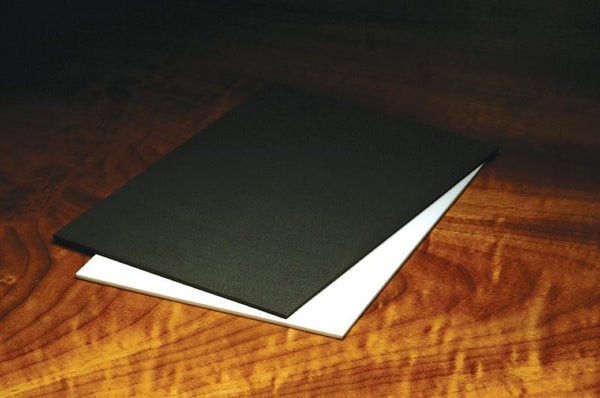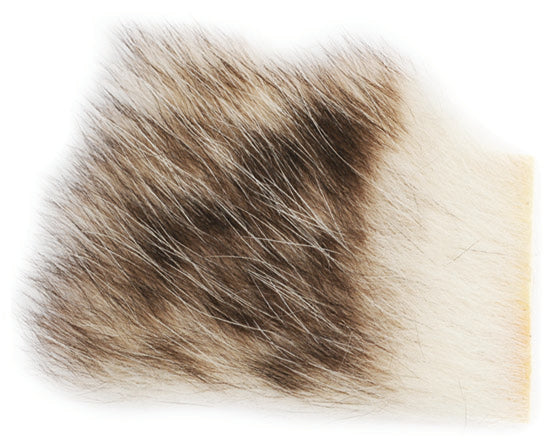- Home
- Blogs
- The Gear
- Accessories and Gadgets
- Chest and Hip Packs
- Floatants and Dressings
- Fly Boxes
- Fly Line and Backing
- Fly Fishing Outfits
- Fly Reels
- Fly Rods
- Fly Rod & Reel Accessories
- Forceps Pliers Scissors
- Hats Gloves Scarves
- Indicators and Splitshot
- Insect Repellents and First Aid
- Lanyards and Tool Keepers
- Leaders Tippet Butt Material
- Sun Protection
- Tenkara
- Waders Boots and Accessories
- Flies
- Fly Tying
- Sign in
Fish-Skull Faux Bucktail
FS-FB6-BL
$ 6.76
Tie flies of all types and sizes from nymphs to Clousers to T-Bones with Fish-Skull Faux Bucktail, a tapered synthetic multi-use fly tying fiber designed to imitate typical premium-length natural bucktail.
Fish-Skull Faux Bucktail fibers have the same basic diameter, gentle crinkle, and taper as natural bucktail. In appearance, it looks almost identical and has the same distinctive bucktail fly or lure action in the water. However, the fibers are not hollow (which helps your fly sink faster) and will not “flare” in the same way as regular bucktail while tying. This means you will need to tie with slightly different techniques to achieve the same effect.
Every Faux Bucktail fiber is premium 6” (152 mm) length, giving you more than twice the amount of usable fibers per tail and eliminating the headache of sorting and searching for ideal strands. Simply peel off the full length of your desired amount of fibers, trim to length, and tie them in.
The fibers can be used in a wide range of fly or lure types.
- Trout flies: Beautiful tapered wrapped “quill” bodies, nymph wing cases, Mayfly tails and legs.
- Streamers: From tying typical Clouser Minnows or Deceivers right up to large, “bite-proof” Pike, Musky or Golden Dorado flies.
- Poppers: Tie simple and durable tails on foam poppers
- Bucktail Jigs: Tougher, longer lasting fresh and saltwater bucktail jigs.
- Musky Bucktail Lures or dressed trebles.
- Note: Faux Bucktail cuts easily, but like most other synthetic materials can be hard on your nice scissors. Use serrated heavy duty scissors designed for synthetics (or an old pair you don’t mind abusing).
More useable fiber than natural bucktail.
Every fiber in the Faux Bucktail pack is useable! You will find that Faux Bucktail has approximately 2-3 times the amount of useable fiber per pack than a typical natural bucktail.
Consistent length.
Unlike natural bucktail, every Faux Bucktail fiber is of premium length (6 inches / 152 mm), eliminating the need to sort and search for ideal length strands and having to discard short hairs and under fibers that are unusable.
Ease of use.
Each Faux Bucktail bundle of fibers is glued together at the base making it easy and convenient to work with. Simply peel off the full length of your desired amount of fibers, trim to desired length, and tie them in. All the fibers are already “pre-stacked,” but like natural bucktail a clump of fibers can be easily pulled and teased out to create a nice tapered tail, wing or body on your fly or lure.
Permanent color and sheen.
Faux Bucktail is available in 12 vibrant, consistent colors that will not bleed onto your hands while tying or fade from constant fishing. The fibers also have a semi-translucent sheen to them in the water which looks great!
Tough & durable.
Designed to hold up to the toothy rigors of big-game fishing (“bite-proof”), Faux Bucktail fibers bond with super glue or other adhesives better than natural fibers, which secures eyes, thread wraps and other materials firmly in place and increases the lifespan of your flies or lures.
Blends well with other materials.
One of the real strengths is that Faux Bucktail is that it blends and combines very well with both natural bucktail and other synthetic/non-synthetic fly tying materials. For example, it helps fly tyers to get more use out of their natural bucktails by providing an easy source of longer fibers that can be combined with the shorter fibers often not fully utilized on a natural bucktail.
Sheds water.
Keep your flies light and easy to cast all day. No more waterlogged flies or lures.
Sinks faster.
Because the fibers are not hollow, Faux Bucktail is not as buoyant as natural bucktail and will sink down into the water column faster. This is usually an advantage.
No smell.
Unlike natural bucktail, Faux Bucktail will make the fish you are targeting (and your spouse) much, much happier!
Performance advantage.
Faux Bucktail has a distinct performance advantage over other synthetic fibers on the market because it is tapered, enabling the fibers to move more naturally in the water like real animal fur. To explain, normal synthetic fibers are not tapered, which means the diameter of each fiber is exactly the same thickness from one end to the other. This creates a consistent stiffness along the full length of the fiber which does not allow the energy generated from the front of the fly or lure (as it moves through the water) to accelerate along the full length of the fiber to the back in the same way that a tapered fiber does. To illustrate this concept, think of how much easier it is to crack a whip than it is to crack a length of rope! In summary, a tapered fiber will give your fly or lure better action.
Like most synthetic fibers, Faux Bucktail is quite slippery and your thread may tend to slip (especially when wrapping a thread head). This can be frustrating, but some small adjustments to your tying technique can make this easier.
i. Use a strong thread (like Veravas 210 denier) and simply spin your bobbin multiple times while suspended from the fly in order to twist your tying thread into a tight “rope”. This gives the thread a nice rough texture which helps bite down and grip into the material.
ii. Put a drop of super glue (like Loctite Gel) on the base before making your first thread wrap. This immediately helps the thread to grab hold and stop slipping forward.
iii. Tie a small “thread ball” about an 1/8” in front of the tie-in point. This creates a small “valley” between the tie-in point and the thread ball to give the Faux Bucktail a place to fold down/sink into when you make your first wraps and overcomes the tendency of the thread to slip forwards.
Q: What does “faux” mean?
A: The word faux is derived from French and the definition is “Made in imitation; artificial. Not genuine; fake or false”
Q: What makes Faux Bucktail different from other synthetic fibers?
A: It’s all about the taper! Faux Bucktail is the first, long synthetic fiber on the market that is naturally tapered to a point like real animal fur.
This taper makes the fibers much more versatile allowing it to be easily used in a variety of ways (from nymphs to pike flies).
It also has a distinct performance advantage over other synthetic fibers on the market because tapered fibers move more naturally in the water. To explain, normal synthetic fibers are not tapered which means the diameter of each fiber is exactly the same thickness from one end to the other. This creates a “consistent stiffness” along the full length of the fiber which does not allow the energy generated from the front of the fly or lure (as it moves through the water) to accelerate along the full length of the fiber to the back in the same way that a tapered fiber does. To illustrate this concept, think of how much easier it is to crack a whip than it is to crack a length of rope! In summary, a tapered end (natural or synthetic) tends to give your fly or lure better action.
Q: Is Faux Bucktail meant to completely replace regular bucktail?
A: No. Natural bucktail is a unique material with certain fly tying properties that cannot be replicated with current technology and it has a place on every fly tyers desk. Faux Bucktail is not intended to be a replacement for every situation in which tyers use bucktail, but does provide fly tyers with an exciting new, synthetic option to supplement their fly tying material arsenal with.
Q: Are the fibers hollow like regular bucktail?
A: No. The biggest difference that fly tyers will notice is the fibers are solid and as a result does not “flare” easily. This means some adjustments to your tying technique will be needed when “hollow” or “reverse” tying in order to achieve similar effects. See Blane Chocklett's instructional videos to learn some quick and easy techniques to achieve this look with Faux Bucktail.
Q: I’m finding the fibers are slippery and my thread is slipping. What can I do?
A: Like most synthetic fibers, Faux Bucktail is quite slippery and your thread may tend to slip (especially when wrapping a thread head). This can be frustrating, but some small adjustments to your tying technique can make this easier.
Try one or all of these tips:
i. Use a strong thread (like Veravas 210 denier) and simply spin your bobbin multiple times while suspended from the fly in order to twist your tying thread into a tight “rope”. This gives the thread a nice rough texture which helps bite down and grip into the material.
ii. Put a drop of super glue (like Loctite Gel) on the base before making your first thread wrap. This immediately helps the thread to grab hold and stop slipping forward.
iii. Tie a small “thread ball” about an 1/8” in front of the tie-in point. This creates a small “valley” between the tie-in point and the thread ball to give the Faux Bucktail a place to fold down/sink into when you make your first wraps and overcomes the tendency of the thread to slip forwards.
See Blane Chocklett's instructional videos for a more in-depth explanation.
Q: What scissors should I use?
A: Warning! Faux Bucktail cuts easily, but like most other synthetic materials can be very hard on your nice scissors! Use one of the serrated, heavy duty scissors designed for synthetics that are now available (or an old pair you don’t mind abusing).
Q: Can I reverse or hollow tie with Faux Bucktail?
A: Yes, but because the fibers are not hollow you will need to make adjustments to your techniques in order to achieve the same effect.
Q: Will Faux Bucktail sink faster than natural bucktail?
A: Yes. Because the fibers are solid and not hollow, Faux Bucktail is not as buoyant as natural bucktail and will sink down faster into the water column. This is usually an advantage
Collections: Everything, Fly Tying, Flymen Fishing Company, Materials, Synthetics
Category: Synthetics
Type: Fly Tying
Related Items
1mm Fly Foam
$ 1.95
1mm Fly Foam available in Black or White California Proposition 65 Warning
View full product detailsAmerican Opossum
$ 1.75
American Opossum hair is frequently used in many dubbing blends as a “binder hair” because it is so easy to dub and it naturally glossy...
View full product details
© 2025 The Trout Spot.
PH: 251-490-9730 - 5700 Brandi Drive Theodore AL 36582 Email: info@thetroutspot.com Hand- Tied Trout Flies Canada and USA
Powered by Shopify


















